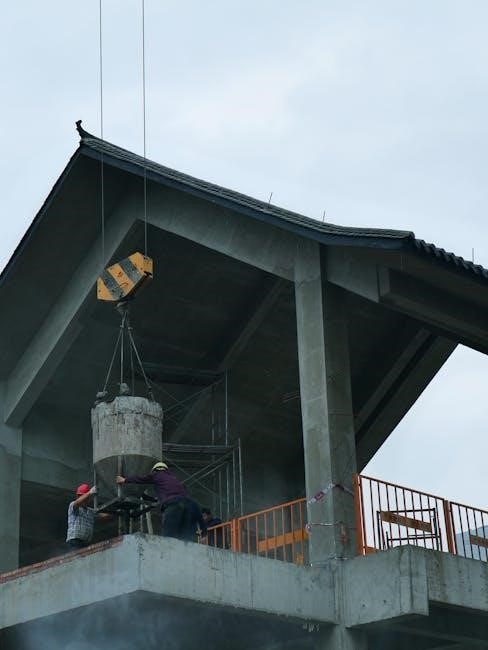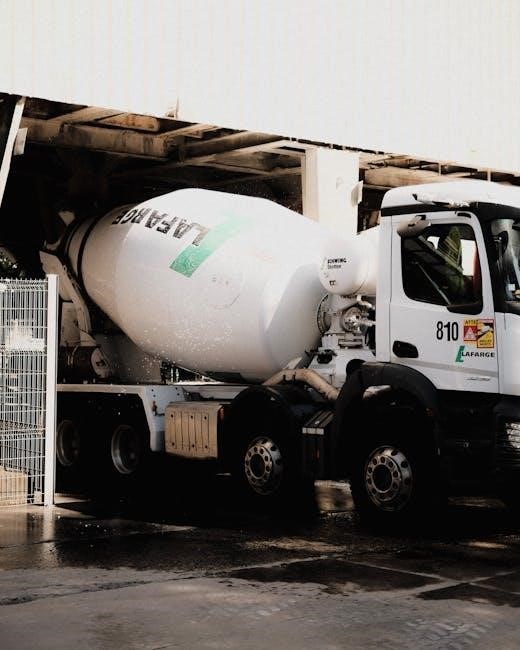
Overview of the Construction Safety Code
The Construction Safety Code (CSTC) is a regulation under the Occupational Health and Safety Act, outlining essential safety standards for construction sites to ensure worker safety and compliance.
The Construction Safety Code (CSTC) is established under the Occupational Health and Safety Act, aiming to eliminate workplace hazards and ensure a safe environment for construction workers. It provides a framework of mandatory safety standards, guidelines, and regulations to prevent accidents and protect the health, safety, and well-being of all individuals involved in construction activities.
1.2 Legal Framework and Jurisdiction
The Construction Safety Code (CSTC) is enacted under the Occupational Health and Safety Act (LSST) in Quebec. It applies to all construction projects, regardless of size, and is enforced by the Commission des normes, de l’équité, de la santé et de la sécurité du travail (CNESST). The code ensures compliance with legal standards to protect workers’ health and safety across the province.

Key Principles and Objectives
The Construction Safety Code aims to eliminate workplace hazards, ensure compliance with safety standards, and protect workers’ health and safety through preventive measures and legal enforcement.
2.1 Risk Assessment and Prevention
The Construction Safety Code emphasizes the importance of risk assessment to identify and mitigate hazards on construction sites. Employers must evaluate potential risks, implement preventive measures, and ensure workers are trained to handle specific dangers. Regular inspections and adherence to safety protocols are essential to maintain a secure work environment and prevent accidents. Documentation of these processes is required to ensure compliance.
2.2 General Safety Standards
The Construction Safety Code establishes minimum safety standards for construction sites, ensuring a safe working environment. It mandates the use of personal protective equipment, proper fall protection measures, and safe scaffolding practices. Employers and workers share responsibility for adhering to these standards, which include regular inspections and compliance with specific safety protocols to minimize hazards and prevent accidents effectively.
Roles and Responsibilities
The Construction Safety Code defines clear roles for employers, workers, and safety coordinators to ensure compliance and maintain a safe work environment. Employers must enforce safety measures, workers must adhere to protocols, and safety coordinators oversee compliance to prevent accidents.
3.1 Employers’ Duties and Obligations
Employers are legally required to maintain a safe work environment, enforce safety measures, and provide necessary training. They must conduct regular inspections, implement control methods for hazardous energy, and ensure all equipment meets safety standards. Employers are also responsible for ensuring compliance with the Construction Safety Code and taking corrective actions to address potential risks. Non-compliance may result in penalties.
3.2 Workers’ Responsibilities
Workers must follow safety protocols, use personal protective equipment, and report hazards. They are required to cooperate with employers, participate in training, and be aware of potential risks. Workers must also adhere to the Construction Safety Code and take personal responsibility for their safety and the safety of others on the construction site. This ensures a safer working environment for all.
3.3 Role of Safety Coordinators
Safety coordinators ensure compliance with the Construction Safety Code, manage risks, and implement preventive measures. They facilitate communication between employers and workers, monitor site safety, and address potential hazards. Their role is crucial in maintaining a safe working environment and ensuring adherence to legal and regulatory requirements on construction sites.
Specific Safety Measures
The Construction Safety Code outlines specific measures to ensure workplace safety, including the use of personal protective equipment, fall protection systems, and scaffolding safety protocols.
4.1 Personal Protective Equipment (PPE)
Personal Protective Equipment (PPE) is essential for preventing injuries and ensuring worker safety on construction sites. The CSTC mandates the use of hard hats, safety glasses, gloves, and respirators where necessary. Employers must provide appropriate PPE and ensure proper training on its use. Compliance with PPE standards is critical to safeguarding workers from hazards such as falling objects, chemical exposure, and electrical risks.
4.2 Fall Protection and Scaffolding Safety
Fall protection and scaffolding safety are critical components of the CSTC, ensuring workers are protected from heights. The code mandates proper scaffolding design, regular inspections, and the use of fall arrest systems. Employers must ensure scaffolding meets engineering standards and that workers receive training on fall prevention and equipment use to minimize risks associated with elevated work areas.
4.3 Control of Hazardous Energy
The CSTC emphasizes controlling hazardous energy to ensure worker safety during maintenance and servicing. Employers must implement methods like lockout/tagout to prevent machinery startup. Proper training is required for workers to handle these procedures effectively, ensuring compliance with safety standards and preventing accidents.

Training and Certification Requirements
The CSTC mandates mandatory training courses for construction workers, focusing on health and safety topics. Certification ensures compliance with safety standards and regulations.
5.1 Mandatory Training Courses
The CSTC requires workers to complete mandatory training, such as the 30-hour General Health and Safety Training course. This program covers risks related to vehicle and personnel circulation, safety rules, and emergency procedures. Specific modules focus on equipment operation, fall protection, and hazardous energy control, ensuring workers are equipped to handle site-specific risks effectively.
5.2 Certification Process
Certification is granted upon completing mandatory training courses, with programs delivered by approved instructors. Certificates are valid for a specific period and must be renewed to maintain compliance. Employers must ensure workers’ certifications are up-to-date and records are maintained. Non-compliance with certification requirements may result in penalties, emphasizing the importance of adherence to CSTC standards.
Compliance and Enforcement
Compliance with the CSTC is enforced through regular inspections by authorities, ensuring adherence to safety standards. Penalties for non-compliance include fines and legal actions to uphold worker safety.
6.1 Inspection Requirements
Regular inspections are mandatory to ensure compliance with the CSTC. These inspections, conducted by authorized personnel, verify adherence to safety standards, documentation, and hazard controls. Employers must maintain detailed records of inspections, corrective actions, and compliance measures. Non-compliance may result in enforcement actions, emphasizing the importance of proactive safety management and regulatory adherence.
6.2 Penalties for Non-Compliance
Non-compliance with the CSTC may result in penalties, including fines and legal actions. Employers failing to meet safety standards face financial repercussions, while severe violations can lead to project shutdowns or criminal charges. Penalties aim to enforce adherence to safety regulations, protecting workers and ensuring accountability within the construction industry.

Recent Updates and Revisions
The CSTC has been updated to enhance safety measures, particularly in fall protection and energy control. These revisions reflect advancements in construction safety standards and practices.
7.1 Latest Amendments to the Code
Recent updates to the CSTC include enhanced requirements for fall protection and scaffolding safety, ensuring compliance with modern safety standards; Amendments introduced in 2023 focus on improving hazard control measures and clarifying training obligations for workers and employers. These changes aim to reduce workplace accidents and ensure adherence to updated safety protocols across all construction sites.
7.2 Impact of Updates on Construction Sites
The latest updates to the CSTC have significantly enhanced safety measures across construction sites. Employers must now provide more comprehensive training, ensuring workers are better equipped to handle risks. These changes have led to improved compliance with safety standards, reducing workplace incidents and fostering a safer environment for all personnel involved in construction projects.

Best Practices for Implementation
Implementing the CSTC effectively involves integrating safety protocols into daily operations, conducting regular site inspections, and fostering a culture of continuous improvement through worker feedback and training.
8.1 Effective Safety Management Systems
An effective safety management system is integral to ensuring compliance with the CSTC. It involves conducting thorough risk assessments, providing ongoing worker training, and implementing regular site inspections. Employers must establish clear protocols for hazard identification and control, while maintaining detailed documentation of safety practices. Adherence to these measures ensures a safer work environment and minimizes potential risks on construction sites;
8.2 Emergency Preparedness
The CSTC emphasizes the importance of establishing robust emergency preparedness measures. Employers must develop evacuation plans, ensure access to emergency exits, and provide communication devices for rapid response. Regular drills and first aid training are mandatory. Sites must maintain emergency equipment and ensure all workers are informed of procedures. Compliance with these standards minimizes risks during unexpected events.
Accessing the Code and Additional Resources
The CSTC is available in PDF format from official sources like CNESST and government websites, ensuring easy access to updated safety regulations and supplementary guidelines.
9.1 PDF Availability and Sources
The Construction Safety Code (CSTC) is readily available in PDF format on official government and regulatory websites, such as CNESST and other authorized sources. This document provides the full text of the code, ensuring easy access for employers, workers, and safety professionals. It is regularly updated to reflect the latest amendments and safety standards.
9.2 Supplementary Guidelines
Supplementary guidelines complement the Construction Safety Code by providing detailed, practical directives for specific aspects of workplace safety. These resources, often available on official websites, include best practices, checklists, and technical specifications to aid in implementing the code effectively. They cover topics such as risk assessments, PPE usage, and fall protection, ensuring comprehensive safety measures are applied consistently across construction sites.
The Construction Safety Code plays a pivotal role in ensuring workplace safety and compliance in the construction sector. By outlining clear standards and guidelines, it aims to minimize risks and protect workers. Regular updates and supplementary resources, such as the PDF version, ensure accessibility and understanding. Adherence to this code is essential for creating a safer and more responsible construction environment.
Leave a Reply
You must be logged in to post a comment.